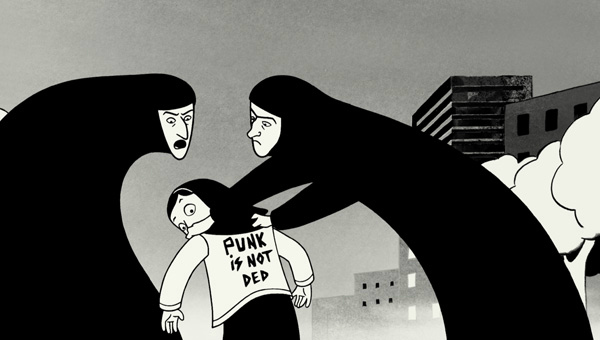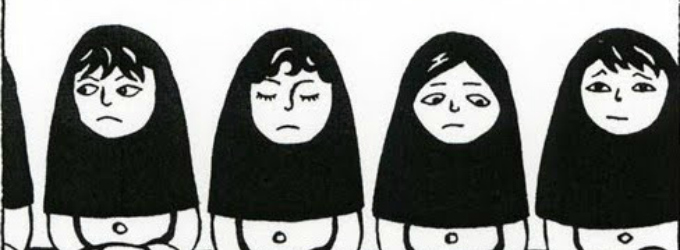httpvh://youtu.be/NZ22VyjJ6n8
The animation in PERSEPOLIS is imbued with a child-like quality of imagination, specifically because it is a coming-of-age film, told through a child’s memories. PERSEPOLIS tells the story of Marjane Satrapi (adapted from her autobiographical graphic novel) as she grows up through the Iranian Revolution, the abolition of the Shah, the Iraqi instigated war, and her adolescence in exile in Vienna. It drew large critical acclaim on its release in 2008, but the cool and vibrant aesthetic of its animation is where the main interest lies.
… visual representations are playful, like stored old drawings in a shoebox.
Principally animated by art director Marc Jousset (who worked on its conversion from graphic novel to animation), its visual style follows the format of the film as a first-person character study of Satrapi. The style evolves and alters at various stages of the narrative, beginning with the plain, rigid lines of the adult world before delving into the memory narrative where visual representations are playful, like stored old drawings in a shoebox. As Satrapi’s father tells her stories of revolution, the visions side-wipe and pan onto the screen. The black figures meld with the environment and each image becomes mutable, like the stream-of-consciousness unfolding the imagination of the main character (which becomes that of the audience). For such a psychological, memory-driven narrative, animation is the obvious choice of medium.
Something of the animation is reminiscent of the nature of PERSEPOLIS as an adaptation. Some elements of the graphic novel are left in, or left in transition. This is aided greatly by the graphic novel’s cool monochrome palette, but in the composition of certain scenes we are left with what looks on-screen very deliberately like paper. As a two-shot of characters in heavy shadow reverse zooms out, we see that the shadow bleeds and fades in to what looks like thick, yellowed paper – the actions have been played out entirely on a page without the viewer knowing it.
There is an obvious similarity between PERSEPOLIS and another eye-opening film on the Middle East: WALTZ WITH BASHIR. They are both first-person character studies; both feature their director as a main character, driven by memories (and often painful ones at that); and both are superbly animated. WALTZ WITH BASHIR, directed by Ari Folman, focuses on the 1982 Lebanese war, specifically on the Sabra and Shatila massacre, and drew the same adverse reaction as PERSEPOLIS did from the Iranian government in Lebanon (where it is officially banned). WALTZ WITH BASHIR is different, however, in that its narrative is purposefully constructed in a documentary style which follows the director as he tries to uncover and retrace his own repressed memories of the atrocities he witnessed in his service during the Lebanese conflict.
… animation is the perfect medium to make your polemic seem innocuous.
The animation here follows two styles. The sections focusing on the director, and his historical research of his own experiences through his soldier comrades, takes the form of Rotoscope animation (the same conversion of digital pixels to animated cells used by Richard Linklater for WAKING LIFE and A SCANNER DARKLY), while the environments and mise-en-scène mutate and segue into the sections built by dream and memory. In the sections devoted to the historical narrative, a different aesthetic is employed – warm colour palettes, sepia tones, a more impressionistic drawing style. Some of these will be silent for long periods, or narrated by voiceover from the outside and eased along by the beautiful score from Max Richter.
These films are not intended to prove anything about animation or make a point about it; their point instead is highly political (both in their own idiosyncratic way), and animation is the perfect medium to make your polemic seem innocuous. Moreover, a sound stage and a film crew are much more conspicuous for any regime to shut your operation down, than an animator’s studio. If it’s released and banned, it’s still a completed release, which I’m sure is much more than lots of political films from Lebanon and Iran have.


